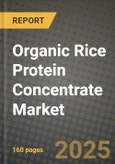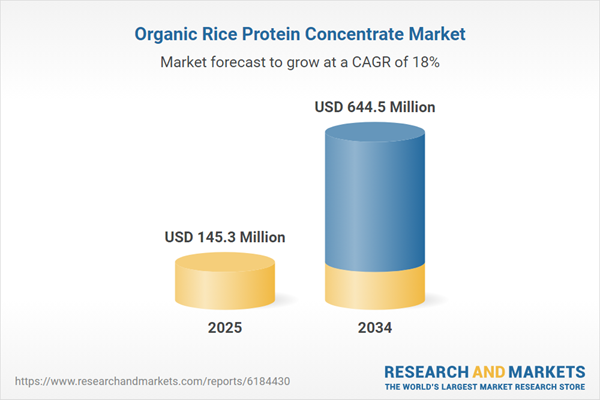Organic Rice Protein Concentrate Market
Organic rice protein concentrate is produced from certified organic brown rice via enzymatic hydrolysis and mechanical separation, yielding 60-85 percent protein powders with clean-label credentials, hypoallergenic positioning, and gluten-free, soy-free, dairy-free appeal. It serves sports and active nutrition (RTM shakes, RTD beverages, bars), plant-based dairy (yogurts, milks, ice cream), bakery and snacks (extruded puffs, high-protein crackers), infant follow-on and maternal products where permitted, medical and elderly nutrition, and pet foods. Formulators value its neutral allergen profile, good digestibility, and complementary amino acid pairing with pea to approach complete protein targets. Functionally, native rice protein has modest solubility and emulsification; processors improve performance via controlled hydrolysis, fine milling, agglomeration/instantization, and lecithination for better dispersion, mouthfeel, and heat/acid stability in RTD systems. Market drivers include growth in plant protein, clean-label and organic preferences, whey and soy avoidance, and sustainability narratives tied to organic farming and traceable supply chains. Key challenges are flavor off-notes (cereal, earthy), sandy mouthfeel if particle size distribution is broad, PDCAAS limitations in isolation, and stringent testing for heavy metals - particularly inorganic arsenic - plus pesticide and allergen cross-contact. The competitive landscape spans integrated rice millers with syrup and protein valorization, specialized protein refiners, and contract spray dryers. Differentiation hinges on organoleptic quality (low grit, low bitterness), verified heavy-metal compliance, instantization for cold water dispersibility, heat/acid tolerant grades for aseptic RTDs, and application support to tune viscosity, sweetness build, and protein fortification without sediment. Emerging themes include organic-certified blends (rice-pea-faba), prebiotic fiber co-formulation for satiety, carbon-accounted SKUs, and regionalizing supply to de-risk logistics.Organic Rice Protein Concentrate Market Key Insights
- Clean-label growth engine. Organic certification, non-GMO, gluten- and dairy-free status expand access to retailers and brands prioritizing short ingredient lists and allergen avoidance.
- Functionality via processing. Enzymatic hydrolysis, tight particle-size control, and agglomeration lift solubility and reduce grittiness - critical for RTD and high-protein bakery without chalky bite.
- Amino acid balancing. Pairing rice (higher sulfur amino acids) with pea/faba (lysine-rich) elevates PDCAAS and improves texture, enabling dairy-like mouthfeel in milks and yogurts.
- RTD readiness. Heat- and acid-stable grades plus lecithination mitigate sediment and phase separation through UHT and shelf life; mineral balance and stabilizer choice are decisive.
- Flavor management. Light enzyme treatments and flavor systems target cereal/earthy notes; sugar reduction strategies rely on bulk sweeteners and fibers to maintain body at lower sucrose.
- Heavy-metal diligence. Lot-level inorganic arsenic and cadmium testing, water source control, and mill segregation are table stakes for infant, pediatric, and premium nutrition claims.
- Supply integration wins. Millers valorizing rice syrup, bran oil, and protein achieve cost resilience and traceability; proximity to organic paddies reduces freight and variability.
- Texture in extrudates. Low ash, optimized moisture, and particle size improve expansion and crunch in puffs and crisps; protein-starch ratios govern cell structure and break force.
- Sustainability to spec. Organic farming narratives, EPDs, and scope-3 reporting differentiate; drought- and methane-reduction practices strengthen retailer scorecards.
- Regulatory and claims. Country-specific organic standards, allergen labeling, and protein quality disclosures require tight documentation; clean-process aids protect label simplicity.
Organic Rice Protein Concentrate Market Reginal Analysis
North America
Strong demand from natural/organic retail and DTC sports brands drives instantized and RTD-capable grades. Buyers emphasize arsenic compliance, bland flavor, and co-development support for plant milks and bars. Local blending and contract drying improve responsiveness.Europe
Retailer standards push rigorous organic certification, contaminant limits, and sustainability documentation. Growth in dairy alternatives and high-protein bakery favors fine-milled, low-grit powders and pea-rice blends; sugar and additive reduction shape formulation choices.Asia-Pacific
Proximity to rice cultivation supports raw supply; Japan/Korea target premium mouthfeel in RTDs, while China/ASEAN scale cost-efficient concentrates for snacks and beverages. Australia/New Zealand expand sports and elderly nutrition with clean-label positioning.Middle East & Africa
Import-led demand centers on allergen-free sports powders and plant milks. Heat-stable, easy-dispersing grades are preferred for ambient logistics; halal certification and robust documentation aid market entry.South & Central America
Growing natural channels adopt organic plant proteins for beverages and bakery. Price stability and local toll-blending are valued; Spanish/Portuguese tech support for viscosity, sweetness build, and extrusion improves first-time-right launches.Organic Rice Protein Concentrate Market Segmentation
By Form
- Dry
- Liquid
By Application
- Sports & energy nutrition
- Beverages
- Bakery & confectionery
- Meat analogs & extenders
- Dairy alternatives
- Others
Key Market players
Axiom Foods, RiceBran Technologies, BENEO, Ingredion, Kerry, Shafi Gluco Chem, Golden Grain Group, AIDP, Top Health Ingredients, Oryza Oil & Fat Chemical, Cambridge Commodities, Bioway Organic Ingredients, Glanbia Nutritionals, The Scoular Company, NutribioticOrganic Rice Protein Concentrate Market Analytics
The report employs rigorous tools, including Porter’s Five Forces, value chain mapping, and scenario-based modelling, to assess supply-demand dynamics. Cross-sector influences from parent, derived, and substitute markets are evaluated to identify risks and opportunities. Trade and pricing analytics provide an up-to-date view of international flows, including leading exporters, importers, and regional price trends.Macroeconomic indicators, policy frameworks such as carbon pricing and energy security strategies, and evolving consumer behaviour are considered in forecasting scenarios. Recent deal flows, partnerships, and technology innovations are incorporated to assess their impact on future market performance.
Organic Rice Protein Concentrate Market Competitive Intelligence
The competitive landscape is mapped through proprietary frameworks, profiling leading companies with details on business models, product portfolios, financial performance, and strategic initiatives. Key developments such as mergers & acquisitions, technology collaborations, investment inflows, and regional expansions are analyzed for their competitive impact. The report also identifies emerging players and innovative startups contributing to market disruption.Regional insights highlight the most promising investment destinations, regulatory landscapes, and evolving partnerships across energy and industrial corridors.
Countries Covered
- North America - Organic Rice Protein Concentrate market data and outlook to 2034
- United States
- Canada
- Mexico
- Europe - Organic Rice Protein Concentrate market data and outlook to 2034
- Germany
- United Kingdom
- France
- Italy
- Spain
- BeNeLux
- Russia
- Sweden
- Asia-Pacific - Organic Rice Protein Concentrate market data and outlook to 2034
- China
- Japan
- India
- South Korea
- Australia
- Indonesia
- Malaysia
- Vietnam
- Middle East and Africa - Organic Rice Protein Concentrate market data and outlook to 2034
- Saudi Arabia
- South Africa
- Iran
- UAE
- Egypt
- South and Central America - Organic Rice Protein Concentrate market data and outlook to 2034
- Brazil
- Argentina
- Chile
- Peru
Research Methodology
This study combines primary inputs from industry experts across the Organic Rice Protein Concentrate value chain with secondary data from associations, government publications, trade databases, and company disclosures. Proprietary modeling techniques, including data triangulation, statistical correlation, and scenario planning, are applied to deliver reliable market sizing and forecasting.Key Questions Addressed
- What is the current and forecast market size of the Organic Rice Protein Concentrate industry at global, regional, and country levels?
- Which types, applications, and technologies present the highest growth potential?
- How are supply chains adapting to geopolitical and economic shocks?
- What role do policy frameworks, trade flows, and sustainability targets play in shaping demand?
- Who are the leading players, and how are their strategies evolving in the face of global uncertainty?
- Which regional “hotspots” and customer segments will outpace the market, and what go-to-market and partnership models best support entry and expansion?
- Where are the most investable opportunities - across technology roadmaps, sustainability-linked innovation, and M&A - and what is the best segment to invest over the next 3-5 years?
Your Key Takeaways from the Organic Rice Protein Concentrate Market Report
- Global Organic Rice Protein Concentrate market size and growth projections (CAGR), 2024-2034
- Impact of Russia-Ukraine, Israel-Palestine, and Hamas conflicts on Organic Rice Protein Concentrate trade, costs, and supply chains
- Organic Rice Protein Concentrate market size, share, and outlook across 5 regions and 27 countries, 2023-2034
- Organic Rice Protein Concentrate market size, CAGR, and market share of key products, applications, and end-user verticals, 2023-2034
- Short- and long-term Organic Rice Protein Concentrate market trends, drivers, restraints, and opportunities
- Porter’s Five Forces analysis, technological developments, and Organic Rice Protein Concentrate supply chain analysis
- Organic Rice Protein Concentrate trade analysis, Organic Rice Protein Concentrate market price analysis, and Organic Rice Protein Concentrate supply/demand dynamics
- Profiles of 5 leading companies - overview, key strategies, financials, and products
- Latest Organic Rice Protein Concentrate market news and developments
Additional Support
With the purchase of this report, you will receive:- An updated PDF report and an MS Excel data workbook containing all market tables and figures for easy analysis.
- 7-day post-sale analyst support for clarifications and in-scope supplementary data, ensuring the deliverable aligns precisely with your requirements.
- Complimentary report update to incorporate the latest available data and the impact of recent market developments.
This product will be delivered within 1-3 business days.
Table of Contents
Companies Mentioned
- Axiom Foods
- RiceBran Technologies
- BENEO
- Ingredion
- Kerry
- Shafi Gluco Chem
- Golden Grain Group
- AIDP
- Top Health Ingredients
- Oryza Oil & Fat Chemical
- Cambridge Commodities
- Bioway Organic Ingredients
- Glanbia Nutritionals
- The Scoular Company
- Nutribiotic
Table Information
| Report Attribute | Details |
|---|---|
| No. of Pages | 160 |
| Published | November 2025 |
| Forecast Period | 2025 - 2034 |
| Estimated Market Value ( USD | $ 145.3 Million |
| Forecasted Market Value ( USD | $ 644.5 Million |
| Compound Annual Growth Rate | 18.0% |
| Regions Covered | Global |
| No. of Companies Mentioned | 15 |









